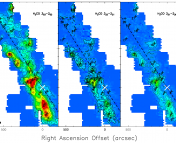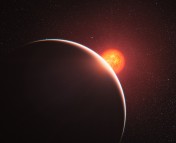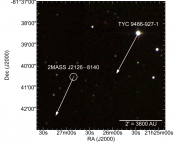
Figure 1. A gorgeous composite image of visible light from Hubble’s WFPC2 instrument and far-infrared light from Herschel’s PACS. The visible light (shown in blue) is emitted by oxygen and sulphur ions, while the infrared light (shown in red) is emitted from dust. Credit: ESA/Herschel/PACS/MESS Key Programme Supernova Remnant Team; NASA, ESA and Allison Loll/Jeff Hester (Arizona State University
- Title: Detection of a Noble Gas Molecular Ion, 36ArH+, in the Crab Nebula
- Authors: M. J. Barlow, B.M. Swinyard, P.J. Owen, J. Cernicharo, H. L. Gomez, R. J. Ivison, O. Krause, T. L. Lim, M. Matsuura, S. Miller, G. Olofsson, E. T. Polehampton
- First Author’s Institution: University College London
- Paper Status: Published in Science
The Crab Nebula is one of my favorite astronomical objects. This hot mess of dust and gas is a supernova remnant and pulsar wind nebula whose genesis was observed by Chinese astronomers in 1054, meaning it’s less than 1,000 years old, or just a baby in astronomical terms. It’s also the source of mysterious high energy flares and of course it’s strikingly beautiful. As if it needed its ego stroked any more (it is, after all, Messier Object 1), the Crab Nebula can now also boast that it’s the first place astronomers have observed a noble gas molecule in space.
Noble gases (helium, neon, argon, krypton, xenon, and radon) are called such because they’re the loners of the periodic table, keeping largely to themselves. You might recall from chemistry class that every atom has some number of electrons, arranged in layers called shells. Each shell can fit a specific number of electrons, and atoms with only partially filled outer shells find it energetically favorable to pair up with other atoms in order to fill out the outermost electron shell. But noble gases are defined by having perfectly filled outer shells on their own, meaning they’re already in a very favorable energy state. This means that it’s rare to find them in molecules with other elements, and they have only been seen that way in laboratory settings–until now.

Figure 2. Herschel’s PACS instrument took the 70 micron infrared image above, while the spectrum was taken with the SPIRE instrument, also on Herschel. The x-axis is given in GHz, but the range corresponds to roughly 660-200 microns. While the astronomers had to do some work to identify the emission lines labeled here as 36ArH+, finding these very strong features was no problem. Credit: ESA/Herschel/PACS, SPIRE/MESS Key Programme Supernova Remnant Team
Barlow et al. did not set out looking to find noble gases in space. Instead, they were looking to better understand the nature of the dust spires clearly visible in Figure 1. Dust absorbs ultraviolet light and re-emits it in the infrared, so the authors used infrared imaging and spectroscopy with the Herschel Space Telescope to investigate. They found an emission line due to OH+, a well known molecule in astrophysical environments. But they also found two strong, unidentified emission lines, seen clearly in Figure 2 (and identified there as 36ArH+). Each dust spire or filament in the Crab Nebula is moving at a different velocity, meaning the light from each filament is Doppler shifted to slightly different wavelengths, and the spectral features appear slightly offset from their true, or rest frequencies. The team had to compare the measured frequency of the OH+ in each filament to its rest frequency, as measured in a lab. Then they could examine the unidentified features and correct them by the same amounts to find the rest frequency of the unknown molecule.
It turns out that the ratio of the two rest frequencies of the unknown spectral features is almost exactly 2 (1.9995 +/- 0.00012), which strongly suggests that the lines are from two different transitions (the 2-1 and 1-0 rotational transition) of the same simple molecule. From there, the authors needed only to look up in a database which molecule emits at the correct frequencies.
They identified the molecule as argon hydride (36ArH+), which is important here because 36Ar was predicted to be the isotope, or variation, of argon produced most during the type of supernova event that gave birth to the Crab Nebula. Finding 36Ar in this molecule confirms this prediction. By comparing the new data to older observations, they also found that the regions that contain the 36ArH+ were already known to contain ionized argon and molecular hydrogen, meaning that the argon hydride is likely formed in the transition region between the neutral and ionized gases.
In addition to giving me an excuse to post lots of images of one of my favorite objects (take one more for the road), this research represents a great proof of concept discovery, that noble gas molecules can and do exist in astrophysical environments.




